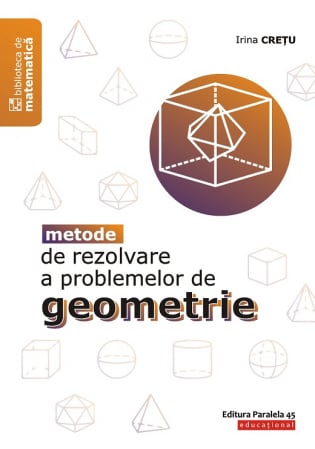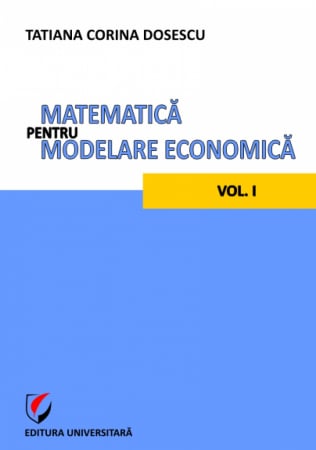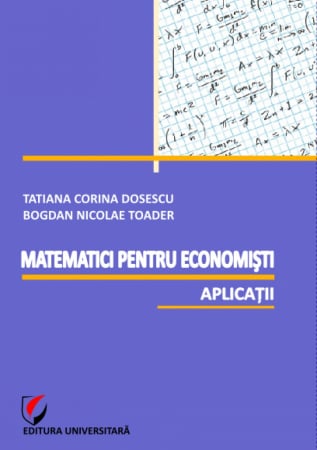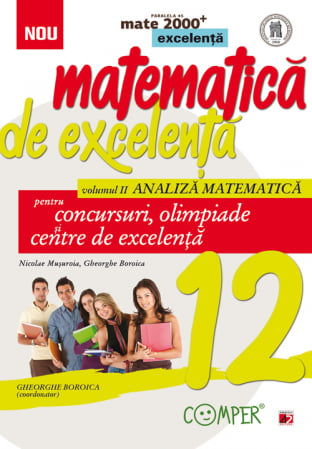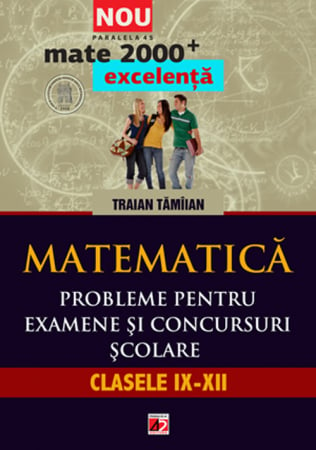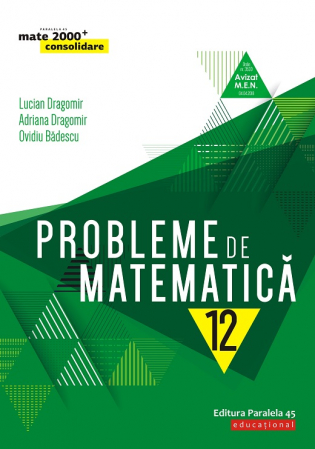ISBN: 978-606-591-856-6
DOI: 10.5682/9786065918566
Publisher year: 2013
Edition: I
Pages: 657
Publisher: Editura Universitară
Author: Tatiana Corina Dosescu
- Description
- Download (1)
- Authors
- Content
- More details
- Reviews (0)
This paper, representing the second volume of mathematics for economists, offers students, bachelors or master students economists the necessary skills to model probabilistically or statistically-inferentially a phenomenon that evolves in an economic environment affected by uncertainty.
This volume is formally made up of two chapters, numbered by 5 and 6, respectively, thus marking the continuation of the numbering started in the first volume. This continuation is justified especially by the fact that the results presented in the first volume constitute the foundation of the knowledge presented in this second volume.
The knowledge of probability theory presented in Chapter 5 is grouped in the following sections: introduction to probability theory, mathematical modeling of an experiment, developments of the probabilistic model, classical probabilistic models, random variables, numerical characteristics of random variables, characteristic function, one-dimensional classical distributions, strings of random variables.
The object of chapter 6 is formed by the sections: selection theory, estimation theory, verification of statistical hypotheses.
The way in which the knowledge is presented was also determined by the desire to take advantage of the framework offered by mathematical modeling in general, but also by the one displayed by probabilistic modeling or statistical-inferential modeling.
-
Mathematics for Economic Vodeling - Volume II
Download
Chapter 5. THE PROBABILITY THEORY / 11
5.1 Introduction to probability theory / 11
5.1.1 Random experiments. Primary notions / 12
5.1.2 Demonstration application / 16
5.1.3. Summary / 21
5.1.4. Concepts and terms of reference / 22
5.2 Mathematical modeling of an experiment / 23
5.2.1 The mathematical model of an experiment with a finite number of elementary events / 23
5.2.2 Body, Borelian body, generator system / 26
5.2.3 The mathematical model of an experiment with an infinitely countable set of elementary events / 29
5.2.4 Product of event fields / 33
5.2.5 Relative frequency of events / 37
5.2.6 Probabilistic modeling of an experiment / 41
5.2.7 Subjective probabilities / 56
5.2.8 Summary / 57
5.2.9 Concepts and terms of reference / 62
5.3 Developments of the probabilistic model / 63
5.3.1 Demonstration application / 63
5.3.2 Independent events / 70
5.3.3 Conditional probabilities / 74
5.3.4 Demonstration application / 80
5.3.5 Independent Borelian fields / 81
5.3.6 Product of Borelian probability fields / 82
5.3.7 Direct sum of probability fields / 83
5.3.8 Summary / 88
5.3.9 Concepts and terms of reference / 93
5.4 Classical probabilistic models / 94
5.4.1 Bernoulli's model or binomial model / 94
5.4.2 The multinomial model / 99
5.4.3 Poisson's model / 105
5.4.4 Passage probabilities / 109
5.4.5 Hypergeometric model / 115
5.4.6 Generalization of the hypergeometric model / 125
5.4.7. Pascal's model / 129
5.4.8 Summary / 133
5.4.9 Concepts and terms of reference / 137
5.5 Random variables / 138
5.5.1 Probabilistic modeling of a random quantity / 138
5.5.2 Distribution, distribution function / 149
5.5.3 Demonstration application / 160
5.5.4 Discrete random variables / 162
5.5.5 Infinite product of probability fields / 170
5.5.6 Continuous real random variables / 173
5.5.7 Demonstration application / 178
5.5.8 Two-dimensional real random variables / 181
5.5.9 Independence of random variables / 190
5.5.10 Demonstration application / 198
5.5.11 Discrete two - dimensional random variables / 201
5.5.12 Demonstration application / 207
5.5.13 Operations with discrete random variables / 210
5.5.14 Continuous two - dimensional random variables / 212
5.5.15 Mixed two - dimensional random variables / 218
5.5.16 Random variables defined on a product field / 223
5.5.17 Functions of two - dimensional random variables / 228
5.5.18 Operations with continuous random variables / 230
5.5.19 Summary / 234
5.5.20 Concepts and terms of reference / 256
5.6 Numerical characteristics of random variables / 258
5.6.1 Distributions of random variables resulting from operations / 258
5.6.2 Numerical characteristics of one - dimensional random variables / 261
5.6.3 Inequalities / 272
5.6.4 Numerical characteristics of two-dimensional random variables. Covariant. Correlation coefficient / 275
5.6.5 Regression lines / 285
5.6.6 Summary / 286
5.6.7 Concepts and terms of reference / 295
5.7 Characteristic function / 296
5.8 Classical one-dimensional distributions / 302
5.8.1 Classical discrete distributions / 302
5.8.1.1 Uniform discrete distribution / 302
5.8.1.2 Binomial distribution (Bernoulli) / 305
5.8.1.3 Poisson distribution / 309
5.8.1.4 Geometric distribution / 313
5.8.2 Continuous classical distributions / 315
5.8.2.1 Continuous uniform distribution / 315
5.8.2.2 Normal distribution / 316
5.8.2.3 Distribution range / 320
5.8.2.4 Exponential distribution / 321
5.8.2.5 Beta / 322 distribution
5.8.2.6 Student Distribution / 323
5.8.2.7 Distribution hi-square / 326
5.8.2.8 Fisher-Snedecor distribution / 329
5.8.3 Two-dimensional normal distribution / 333
5.8.4 Generating random variables using the computer / 337
5.8.5 Summary / 340
5.8.6 Concepts and terms of reference / 354
5.9. Strings of random variables / 356
5.9.1 Types of convergence / 356
5.9.2 Limit theorems / 361
5.9.3 Law of large numbers / 364
5.9.4 Summary / 372
5.9.5 Concepts and terms of reference / 377
5.10 Problems Solved / 378
5.11 Proposed issues / 422
Chapter 6. MATHEMATICAL STATISTICS / 439
6.1 Introduction to metematic statistics / 439
6.2 Elements of selection theory / 440
6.2.1 Bernoulli selections / 445
6.2.2 Selection functions / 457
6.2.2.1 Initial selection moments / 457
6.2.2.2 Centered selection moments / 460
6.2.2.3 Demonstration application / 464
6.2.3 Selections from a normal population / 466
6.2.4 Asymptotic behavior of selection moments / 472
6.2.5 Demonstration application / 474
6.2.6 Summary / 475
6.2.7 Concepts and terms of reference / 486
6.3 Elements of estimation theory / 488
6.3.1 Punctual estimation / 490
6.3.1.1 Punctual and estimated estimatorsii punctual / 490
6.3.1.2 Punctual estimation methods / 496
6.3.1.2.1 Method of moments / 496
6.3.1.2.2 Maximum probability method / 500
6.3.2 Estimation by confidence intervals / 508
6.3.2.1 Confidence interval for the parameter m of the distribution N (m, σ) when σ is known / 511
6.3.2.2 Confidence interval for the parameter m of the distribution N (m, σ) when σ is unknown / 516
6.3.2.3 Confidence interval for σ2 the square of the parameter σ of the distribution N (m, σ) / 519
6.3.3 Summary / 523
6.3.4 Concepts and terms of reference / 533
6.4 Verification of statistical hypotheses / 534
6.4.1 Introductory notions / 534
6.4.2 Statistical tests / 538
6.4.3 Tests regarding the parameters of the normal distribution / 542
6.4.3.1 Test Z / 542
6.4.3.1.1 Bilateral Z test / 543
6.4.3.1.2 Right unilateral Z test / 545
6.4.3.1.3 Left unilateral Z test / 547
6.4.3.2 T / 549 test
6.4.3.2.1 Bilateral T test / 551
6.4.3.2.2 Right unilateral T test / 553
6.4.3.2.3 Left unilateral T test / 554
6.4.3.3 Test F / 556
6.4.4 Nonparametric tests (concordance) / 563
6.4.4.1 Hi-square concordance test / 564
6.4.4.2 Kolmogorov concordance test. / 572
6.4.5 Abstract / 577
6.4.6 Concepts and terms of reference / 593
6.5 Problems Solved / 594
6.6. Proposed issues / 618
BIBLIOGRAPHY / 624
ANNEX / 627
Tables / 648
An important category of economic phenomena occur in an environment invaded by uncertainty, a factor that can prevent the employee from making the right decision, generating profit.
The approach of the economic environment in which uncertainty plays an essential role presupposes a special competence on the part of the one who makes this enterprise, reason for which this volume is addressed to the student, bachelor or master student in economics and even to all those who want to acquire this specialization.
Appropriate means in overcoming the effects of uncertainty exist, and these means are also acquired by accumulating knowledge from probability theory or mathematical statistics.
Economic modeling receives a first-rate support from probability theory, which being a mathematical theory of empirical origin has as object of study the modeling of phenomena with at least one random component, the attribute "random" certifying the presence of uncertainty in the evolution of the phenomenon.
Secondly, economic modeling receives from mathematical statistics a consistent offer of techniques and methods, specially created to elaborate in conditions of uncertainty decisions rigorously substantiated in fields such as: trade, tourism, marketing, finance, agriculture, industry, property and personal insurance, economic forecast for different terms, medicine and enumeration could continue.
This volume is formally made up of two chapters, numbered by 5 and 6, respectively, thus marking the continuation of the numbering started in the first volume. This continuation is justified especially by the fact that the results presented in the first volume constitute the foundation of the knowledge presented in this second volume.
The knowledge of probability theory presented in Chapter 5 is grouped in the following sections: introduction to probability theory, mathematical modeling of an experiment, developments of the probabilistic model, classical probabilistic models, random variables, numerical characteristics of random variables, characteristic function, one-dimensional classical distributions, strings of random variables.
The object of chapter 6 is formed by the sections: selection theory, estimation theory, verification of statistical hypotheses.
The content of chapter 5 introduces the reader to a space in which the probabilistic thinking and inventiveness of the probabilistic mathematician has built notions and theoretical tools adequate to quantify the chance to be realized in an uncertain environment of a random phenomenon. The one who accumulates the knowledge offered in this chapter acquires the competence to probabilistically model the economic phenomena affected by uncertainty.
The presentation in Chapter 6 is made in a framework provided by mathematical modeling in general and probabilistic modeling in particular. The presentation emphasizes, whenever necessary, the distance between the probabilistic model built on the basis of hypotheses and the modeled statistical reality, the distance that requires the specification of modeling errors caused by the presence of uncertainty. The accumulation of knowledge in this chapter generates the competence to think and model statistically-inferentially.
Each section ends with a summary, followed by a list of representative concepts and notions, and each chapter ends with solved applications and applications proposed for solving, with the corresponding answers.

6359.png)
![Mathematics for Economic Vodeling - Volume II [1] Mathematics for Economic Vodeling - Volume II [1]](https://gomagcdn.ro/domains/editurauniversitara.ro/files/product/large/matematica-pentru-modelare-economica-vol-ii-1199-146425.jpg)
